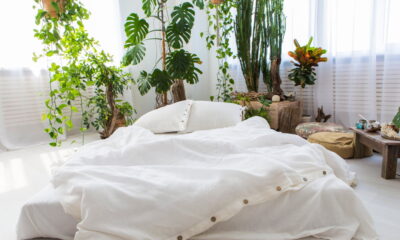

Environment
5 Wonderful Sustainable Sleep Products To Slash Your Carbon Footprint
I recently had a very uncomfortable discussion with my friend Sheila about sustainable living. She says that she is highly committed to sustainable living. However, she rarely makes the lifestyle changes needed to embrace a truly eco-friendly lifestyle.
Sheila isn’t alone. A study from Columbia University found many people simply don’t take the steps necessary to lead eco-friendly lives, even when they want to.
The truth is that it takes a lot of changes to lead a green life. You need to think about all the consumer choices you make and the things you can do to lower your carbon footprint. Even your sleeping habits may need to be altered to embrace a sustainable lifestyle.
You spend about one-third of your life sleeping. If you’ve already gone “green” by choosing organic foods, sustainable clothing and low-emissions furniture and paint, it’s time to take a look at what’s in your bedroom. The quantity of time you spend in your bedroom means that investing in sustainable linens, furnishings and accessories could go a long way in improving your health and well-being.
I got the inspiration to talk about this topic after reading a great article on Eco Salon about sustainable sleeping habits. That article was older though, so I wanted to update it to cover some of the newer sustainable sleep options out there.
Here are five ideas for sustainably made products to help you sleep better.
1. Pillows
Your head rests on your pillow all night. It comes into contact with your eyes, nose and mouth. It’s wise to choose a pillow made of non-toxic materials. If possible, select a pillow filled with natural materials, such as natural latex or hemp. If you’re not allergic, try a horsehair or wool-filled pillow. Natural shredded rubber is also an environmentally friendly option. These materials are porous, so be sure to choose a pillow encasement in order to prevent a dust mite infestation. There are non-toxic pillow encasement products that fit standard- to king-size bed pillows.
2. Linens
Choose bed sheets, pillowcases and mattress toppers that are made from natural or organic materials. Look for fabrics with a high thread count for durability and softness. Some good fabric options include bamboo and blends, organic cotton, ramie, rayon, hemp and silk. If you don’t mind a slightly rougher texture, try nettle fiber or linen. Look at the type of dye used on the fabric, and check to make sure that it’s non-toxic. For the colder months of the year, try natural wool. The wool wicks away moisture and helps you stay warm. Wool is also a good choice for a blanket, quilt or comforter. When choosing a duvet, look for one that has an organic or natural insert.
3. Mattress
You spend hours every night on your mattress. Some mattresses are laden with harsh chemical flame retardants or have petroleum products that off-gas chemicals for a long time. Fortunately, there are many comfortable mattresses made from sustainable and natural or organic materials. Some good options include natural latex foam for the interior and organic cotton, natural wool or bamboo for the outer layer. Look for a quality mattress with CertiPUR-US, GreenGuard, Global Organic Textile Standard or Global Organic Latex Standard certifications.
4. Bed Frame
Bed frames made from plastics or coated in oil-based paints may off-gas volatile organic compounds. These compounds are harmful to your health. Choose sustainable materials, such as steel. It’s strong, recyclable and doesn’t require any sealants. Wood or bamboo with a water-based paint may also be a good choice. A piece of antique furniture from your grandmother is likely done with off-gassing, so that could be another option.
5. Pajamas
Your pajamas come into contact with your skin for six to eight hours per day, so it’s a good idea to choose some that are made from natural or organic materials. Bamboo is a good choice. It’s hypoallergenic, wicks away moisture and grows without the need for pesticides. Organic cotton and natural wool are also good choices for sleepwear. Be sure to launder your pajamas in an eco-friendly detergent and consider using wool dryer balls instead of chemical-laden dryer sheets.
Make Eco-friendly Sleep Habits Part of Your Life
You need to change your lifestyle habits if you want to show your support for the environment. There are a lot of ways that you can change the way you sleep to be more eco-friendly. The five tips listed above are a great start!


 Environment10 months ago
Environment10 months agoAre Polymer Banknotes: an Eco-Friendly Trend or a Groundswell?

 Environment11 months ago
Environment11 months agoEco-Friendly Home Improvements: Top 7 Upgrades for 2025

 Features9 months ago
Features9 months agoEco-Friendly Cryptocurrencies: Sustainable Investment Choices

 Features10 months ago
Features10 months agoEco-Friendly Crypto Traders Must Find the Right Exchange


























